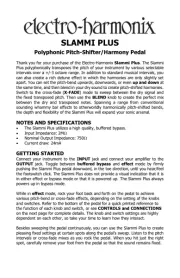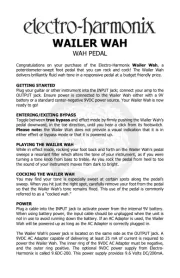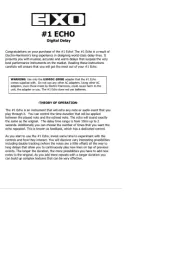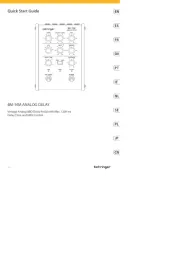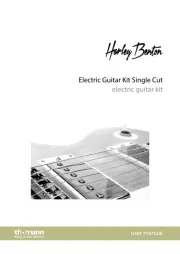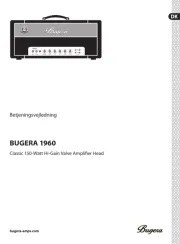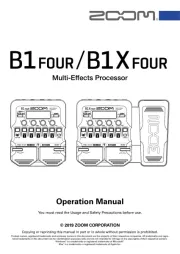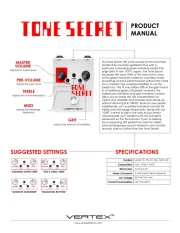
(PSA series; sold separately)
This adjusts the volume of the eect sound.
Clockwise rotation raises the volume and counterclockwise rotation decreases.
7Overdrive and distortion have been combined into one compact eects unit.
7You are provided with a wealth of new sound creation possibilities as a result of the mixture of overdriven and distorted sounds.
7The unit equipped with a COLOR knob which allows you to adjust at will the respective portions included in the sound mixture.
7A overdrive that really sounds like it comes from a large-scale tube amp is created as a result of the unique BOSS “Asymmetrical Overdrive Circuitry” that is incorporated in the unit.
Connect an amplier to this jack.
Accepts connection of an AC Adaptor (PSA series; sold separately). By using an AC Adaptor, you can play
without being concerned about how much battery power you have left.
* We recommend that you keep batteries installed in the unit even though you’ll be powering it with
the AC adaptor. That way, you’ll be able to continue a performance even if the cord of the AC adaptor
gets accidentally disconnected from the unit.
* Use only the specied AC adaptor (PSA-series).
* If the AC adaptor is connected while power is on, the power supply is drawn
This indicator shows whether an eect is ON/OFF, and doubles as the Battery Check indicator.
The indicator lights when an eect is ON.
* If this indicator goes dim or no longer lights while an eect is ON, the battery is near
exhaustion and should be replaced immediately.
This adjusts the tone of the eect sound.
As you rotate the knob clockwise, higher frequencies are emphasized, and
counterclockwise cuts them.
This switch turns the eects ON/OFF.
When this screw is loosened, the pedal will open, allowing you to change the
* For instructions on changing the battery, refer to “Changing the Battery.”
This adjusts the degree to which the overdrive/distortion is applied.
Turning this knob clockwise rotation increases the distortion, producing a more
intense sound. Turning it counterclockwise rotation decreases the distortion.
This adjusts the balance between the overdrive and distortion.
Turning this knob clockwise rotation increases the proportion of distortion
sound; turning it counterclockwise rotation increases the proportion of
* When the knob is turned to one or the other extreme, you obtain solely
either the distortion or the overdrive eect.
IPrecautions When Connecting
To prevent malfunction and equipment failure, always turn
down the volume, and turn o all the units before making any
Once the connections have been completed, turn on power to
your various devices in the order specied. By turning on devices
in the wrong order, you risk causing malfunction and/or damage
to speakers and other devices.
When powering up: Turn on the power to your guitar amp last.
When powering down: Turn o the power to your guitar amp rst.
Before turning the unit on/o, always be sure to turn the volume
down. Even with the volume turned down, you might hear some
sound when switching the unit on/o. However, this is normal and
does not indicate a malfunction.
A battery was installed in the unit before it left the factory. The life
of this battery may be limited, however, since its primary purpose
If you handle batteries improperly, you risk explosion and uid
leakage. Make sure that you carefully observe all of the items
related to batteries that are listed in “USING THE UNIT SAFELY” and
“IMPORTANT NOTES” (supplied on a separate sheet).
When operating on battery power only, the unit’s indicator will
become dim when battery power gets too low. Replace the
battery as soon as possible.
Batteries should always be installed or replaced before connecting
any other devices. This way, you can prevent malfunction and
Nominal Input Level -20 dBu
Power Supply Carbon-zinc battery (9 V, 6F22) or
Alkaline battery (9 V, 6LR61)
AC adaptor (PSA series: sold separately)
* Expected battery life under continuous use:
These gures will vary depending on the
actual conditions of use.
Dimensions 73 (W) x 129 (D) x 59 (H) mm
2-7/8 (W) x 5-1/8 (D) x 2-3/8 (H) inches
Weight 385 g / 14 oz (including battery)
Accessories Leaet (“USING THE UNIT SAFELY,” “IMPORTANT
NOTES,” and “Information”)
Carbon-zinc battery (9 V, 6F22)
* This document explains the specications of the product at the
time that the document was issued. For the latest information,
refer to the Roland website.
Before using this unit, carefully read the sections entitled: “USING THE UNIT SAFELY” and “IMPORTANT NOTES” (supplied on a separate sheet).
After reading, keep the document(s) where it will be available for immediate reference.
This jack accepts input signals (coming from a guitar, some other electric or
electronic musical instrument, or another eects unit).
* The INPUT jack doubles as the power switch.
Power to the unit is turned on when you plug
into the INPUT jack; the power is turned o
when the cable is unplugged.
To prevent unnecessary battery consumption,
be sure to disconnect the plug from the
INPUT jack when not using the eects unit.
© 2018 Roland Corporation
1. When you have made the necessary connections, set
the knobs as shown in the illustration.
2. Press the Pedal Switch and make sure that the CHECK
3. Using the COLOR knob adjust the balance between the
distortion and the overdrive.
When turned clockwise, the distorted sound proportion is increased.
When turned counterclockwise, the overdriven sound proportion is
increased. When the knob is turned to the other extreme, you obtain
solely either the distortion or the overdrive eect.
4. Using the DRIVE knob adjust the degree to which the
The further it is moved clockwise, the greater the distortion becomes.
5. Using the TONE knob, adjust the tone of the sound
heard when the eect is on.
The further it is moved clockwise, the more the upper range is
enhanced, and the sharper the sound becomes.
6. Using the LEVEL knob, adjust the volume of what is
heard when the eect is on.
It should be adjust so there is no dierence in volume between when
the eect is on and when it is o.
1. Hold down the pedal and loosen the thumbscrew, then
* The pedal can be opened without detaching the thumbscrew
2. Remove the old battery from the battery housing, and
remove the snap cord connected to it.
3. Connect the snap cord to the new battery, and place
the battery inside the battery housing.
* Be sure to carefully observe the battery’s polarity (+ versus -).
4. Slip the coil spring onto the spring base on the back of
the pedal, and then close the pedal.
* Carefully avoid getting the snap cord caught in the pedal, coil
spring, and battery housing.
5. Finally, insert the thumbscrew into the guide bush
hole and fasten it securely.





